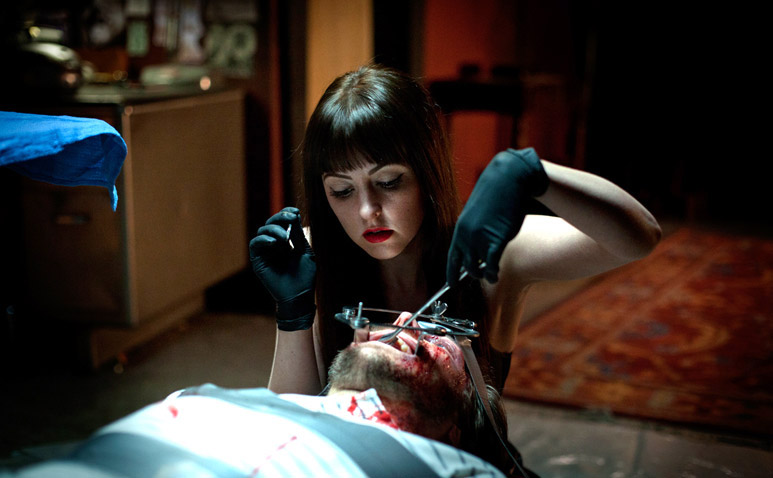Written by Eva Phillips, this article is part of our theme week on Women in Horror.
[Trigger warning: discussion of rape]
Suturing, as an act, sanguinely carves its way throughout Jen and Sylvia Soska’s 2012 body-modification-centric horror film American Mary. Before we ever see a face or hear a word of dialogue, we watch sinewy, achromatic flesh being sliced open, spread apart, and methodically stitched with black thread by blacked gloved fingers. We watch this, stunned by the juxtaposition between the very focused, dotingly nimble work of the gloved fingers and the grotesquely wrinkled and malleable flesh. We watch this also jarred by the ethereally doleful rendition of “Ave Maria” — importantly and perspicaciously, a hymn that beseeches a female savior to ward off earthly demons and evils — that sonically sutures into the slicing and massaging of the flesh. Before we ever see a face or hear a word, we are informed that this suturing is an act of salvation, not something to be reduced to a simple barbarism. As it is portrayed in the first few moments of the film, suturing is a complex extension of the two selves involved in the act.
These first scenes of suturing — which, as we are shown in an almost whimsical reveal, involve dead turkey flesh rather than human flesh — introduce us to the proclivities of the film’s protagonist, Mary (an unequivocally cool as hell Katharine Isabelle), a profoundly bright and profoundly broke medical student in her final stages of schooling before becoming a surgeon. Before understanding Mary as an individual, we are introduced to the presences in Mary’s life which vex and threaten her in strikingly insidious ways. Specifically, her sniveling, vitriolically brooding professor, Dr. Grant (David Lovgren), is presented moments after we watch Mary carefully and gleefully “operate” on her turkey patient as a direct contrast to the joy she derives from her chosen field. During a slideshow presentation in class, in which Mary’s phone is bombarded with messages and calls from debt collectors for defaulting on her loans, Dr. Grant lashes out at Mary in the middle of class, barking that having her phone out is “fucking rude” and later admonishing her to “stop fucking up.” This violence through language establishes a paradigm that persists throughout the film in which female expression, female control over their anatomy/body and others’ is aggressively and oppressively impugned upon and violated by male domination. Mary’s passion and talent — and thus selfhood — exists imperiled and impeached by the overtures of men.
To juxtapose this, the Soska Sisters brilliantly introduce, through their own masterful process of directorial and narrative suturing, the world of underground body modification and Mary’s unexpectedly intimate and empowering relationship with it. Body modification, which has longstanding cultural values and implications, has emerged as a prominent subculture in which individuals seek to perfect and alter their form to their vision using techniques such as implants, scarification, surgical reconfiguration of particular body parts, and more. The culture is known for a wide array of widely sought after artists — like this guy — and informs many films and television shows, particularly those examining transcendentalism in scientific-modification communities — think Orphan Black — and the multidimensionality of the culture has permeated the filmic consciousness in significant ways.
In American Mary, Mary is thrust into the belly of the beast rather unceremoniously and under non-consensual pretexts: in her interview at a beyond-grimy strip club to secure a job to make more fast cash, Mary is implored by her potential future employer to stitch together an identity-less man who has been brutalized and ripped stem-to-stern by the club’s bouncer. Mary sutures the man’s wound in exchange for five thousand dollars cash, violently vomiting afterword, and in turn imbricates herself into a world which will challenge her to re-conceptualize her notions of autonomy and self-governed craft.
What is significant about Mary’s consequential immersion into the world of body modification is that it is engaged by (very) willing, consenting participants who are firstly and predominantly women. As pertinacious as they are distinct in their appearance, the women who help to “launch” Mary’s body-mod specific surgical career — Beatress (Tristan Risk) and Ruby Realgirl (Paula Lindberg), who seek to surgically modify their appearances to resemble Betty Boop and a human doll — value body mod and surgical transformation as a distinct form of sovereign self-possession that reclaims bodies otherwise controlled or possessed by external forces. Grandiosely, Ruby summarizes the allure and the empowerment of body mod, stating “I don’t think it’s really fair that God gets to choose what we look like on the outside, do you?”
This sort of direct control over one’s physical features, particularly when enacted by women/for women, this craven need for specific suturing that allows Mary to not only hone her craft, but define herself through her knack for flawlessly changing skin and bodies. She articulates her selfhood with each stitch while simultaneously allowing those she operates on to attain their purest selves. It is certainly no coincidence that during Mary’s operation on Ruby, the rendition of “Ave Maria” we hear in the opening scene is woven in to the scene just as effortlessly as Mary’s surgical tools carve and reshape Ruby’s flesh. Both women are symbiotically asserting selfhood through an act often thought to barbarously or carnally be “just for men.”
Themes of feminine self-expression and self-possession take on another dimension in turns of representation when the disturbing element of bodily violation (through rape) is jarringly introduced into the film’s narrative. Mary, who has purchased a new car and clothes with the exorbitant gobs of under-the-operating-room-table money she makes through body mod, attends a party hosted by the repulsively skeevy Dr. Grant, where she is a lone female presence surrounded by lecherous men in her desired field. Already coded as a predator, we are not shocked but nevertheless paralyzingly appalled as Dr. Grant drugs and rapes Mary, all while filming the violent transgression. It would almost seem this act, and the Soska’s directorial choice to unflinchingly present the violation in its entirety (often from Mary’s “perspective”) betrays the trenchant themes of female self-possession and autonomous expression established in the film, and falls into the triggering and tiresome trend of rape and sexual assault in other films. However, keeping with the Soska’s own sentiments conveyed in their 2014 interview with Bitch Flicks, the inclusion of the graphic assault scene is reflective of the prevalence of violence against women — sexual, physical, emotional, and so on — that is often ignored, disputed, or monetized. The violence that is acted upon Mary is not a plot device nor a gratuitous exploitation of the female body — and the ensuing violence she enacts as either retribution or psychological processing is not portrayed as erotic or glamorous. Rather, it is seen as coping — tasteless, merciless, and often directionless coping to contend with an act that defied explanation. What is critical, though, is that Mary never loses nor surrenders her mastery over suturing and the identity she consecrates through that (though, she does relinquish from the male-dominated “legitimate” surgeons’ realm). Even down to her final moments, she is in control of her craft and identity.
I found myself oddly calling upon a seemingly unrelated text during my viewings of American Mary. With each scene, moments from English novelist Frances Burney’s agonizing epistolary non-fiction piece, “Letter to Esther Burney,” began to suture themselves, as it were, to the action of the film. Burney’s groundbreaking and painfully vivid description of her diagnosis with cancer, the complete deprivation of her voice and autonomy over her own body at the hands of countless male physicians both before and during the mastectomy, and gruesome accounts of the gore and pain of the surgery, are eerily connected to the work done in American Mary.
While both the film and text depict outlandish trauma acted on bodies — whether it be Mary’s rape or Burney’s invasive cancer and equally invasive and debasing procedure to remove it — both reinstate women’s voices and female autonomies in unconventional means. Burney is able to champion her suffering by authorially disseminating her trauma in text, and thus re-transcribes herself into the surgical act which initially strips her of her selfhood. Mary, an author in her own right through her magisterial surgical prowess that defies the parameters of her patriarchal field, literally carves out her own voice and her own sense of control (for better and for worse) through modifying the bodies of others (which in turn allows those individuals to inhabit empowered identities) and altering the man who violated her. Both women confront their trauma, the desecration their bodies endure, by refusing to relinquish the crafts which define them and allow them to reclaim their bodies.
The ethics in American Mary are often dubious at best, but as in Burney’s letter the empowerment of the text — as is often the case with what little room women are allowed to articulate themselves in — lies in ferocious audacity sutured in each line or each layer of flesh.
See also at Bitch Flicks:
American Mary: In Praise of the Amoral Final Girl
Talking with Horror’s Twisted Twins: An Interview with the Soska Sisters
Eva Phillips is a relatively recent import to Pittsburgh, PA. She relocated from the crust of Virginia after receiving her BA in English at the University of Virginia to complete her Masters at Carnegie Mellon University. Her interests include: representations of femininity and violence in film, refusing to quell her excitement over The Fast and the Furious franchise; having every cat; queer representations in horror and melodrama (both film and television); queer sexuality and religion; and finally getting to meet Sia and maybe wear her wig. In addition to Bitch Flicks, she writes for the good folks at Indie Film Minute, and has appeared in Another Gaze Journal. Her various disintegrations can be viewed at https://www.instagram.com/menzingers2/.







